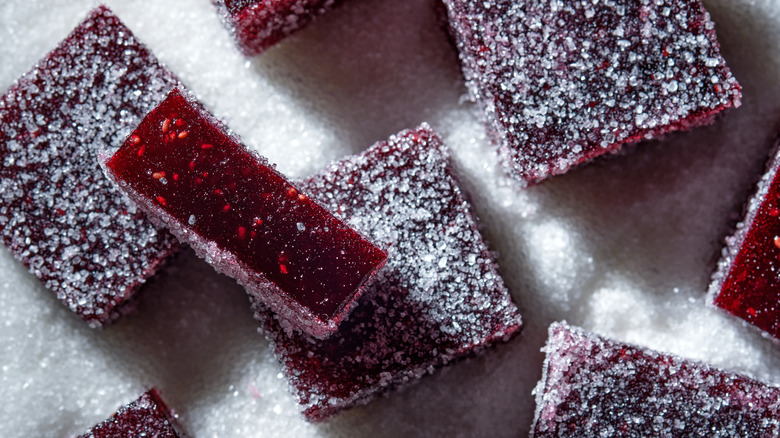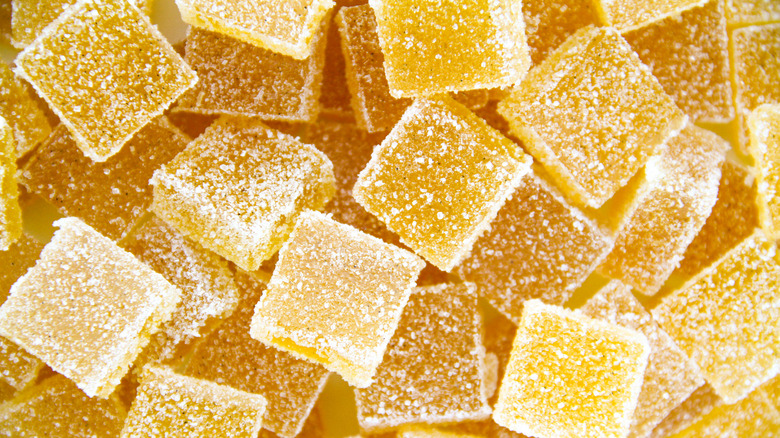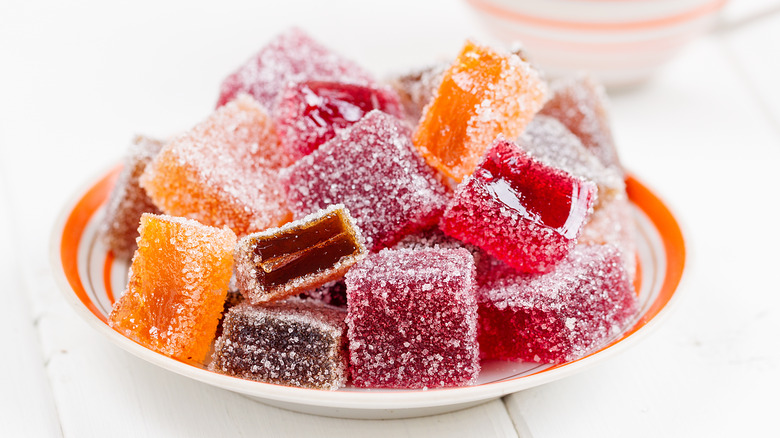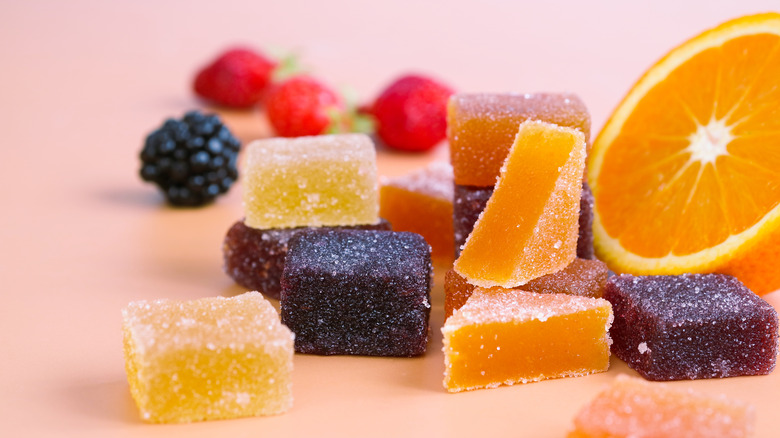Pâte De Fruit: The French Treat That Takes Gummies To The Next Level
For the average person, the word pâte evokes a savory paste made of poultry, beef, or seafood. In Richard Olney's Simple French Food, you'll find an impassioned diatribe against the confusion of the terrine for the pâte, which states that pâte is not the pulverized mound of meat served with crackers, but the version with a pastry encasing it. But pâte is defined as a paste, pastry, or dough, which explains the confusion about what it is. The pâte de fruit is, in some ways, a paste and a dough. As fruits are often referred to as "candy of nature," the pâte de fruit literally is a candy of nature, mostly made from the pulp of a fruit.
You can imagine something that tastes like an organic Sour Patch gummy, or a Turkish Delight in both appearance and texture. This refined French confectionery has its roots in Roman Antiquity, where fruits were first preserved with large amounts of sugar, per Biscuits et Compagnie. First, we'll find out how this fruit candy developed from an arcane syrup to a chewy palate cleanser.
Origin
The pâte de fruit's Roman predecessor, defrutum, usually took on the form of a syrup or jam, but no matter its consistency, it was defined by its preservation technique, as per Tavola Mediterranea. Defrutum was often made from a reduction of grapes or wine in sugar, which made it into a thick syrup, most similar to today's balsamic glazes. Douceurs Etoilles traces the actual pâte de fruit back to the Middle Ages when the French began to use sugar to preserve fruit, calling anything with sugar a "confiture" or jam. Thus, before it earned its name, the pâte de fruit was called dried jam or confiture sèches.
France Today claims this dried jam was invented in the city of Clermont-Ferrand, back in the 10th century, when locals began preserving their apricots in sugar. When this chewy bonbon became highly sought-after during the Age of the Enlightenment, the distinction between the jam and the gummy had to be made. Among its fans were elites like the philosopher Voltaire and relatives of Napoleon III. Its high status eventually granted the pâte de fruit an entry in the Encyclopédie des Lumières, according to Biscuits et Compaigne.
How is pâte de fruits made?
One can guess that this candy begins with fruit and sugar. Any fruit would work, but Ewald Notter's The Art of the Chocolatier details the preferred adjustments made to a pâte de fruit recipe depending on the fruit. More tart fruits like raspberries yield excellent flavors with a simple sugar coating, but sweeter fruits can be enhanced with citric acid, which adds tang to balance the sweet with sour.
The pâte de fruit looks like gummy candy as we see them in the stores, though perhaps more opaque in color. Notter's pâte de fruit recipe calls for pectin, sugar, and fruit puree. The pectin and sugar are dissolved and mixed in with a heated fruit puree and combined with a hot tartaric acid solution. Then you carefully pour the mixture into a silicone mold with the shape of your choice, usually a square or half-spheres. When you sub in a flat square mold, you must slice them into small, bite-size cubes. The gummies are left to harden, and then they are coated in sugar or a mixture of sugar and citric acid.
They have a higher fruit content than gummies from the store and are set with pectin, which is a naturally-occurring fiber found in the skins and pulp of fruits, rather than gelatin (via WebMD).
Variations
The first pâte de fruits in Clermont-Ferrand were made from apricots, quince, and oranges. However, as with all modern food, pâte de fruits can now be made with any ingredient – some producers even use alcohol, like Yami Yami's blackberry and gin pâte de fruit. Their website advertises this old French treat as a vegan gummy, which may be the reason it became popular again. Unlike other gummy products, pâte de fruits use pectin, which is a great vegan substitute for gelatin. Perhaps the delicacies which were laid on a silver platter in the Parisian salon are now appealing to the conscious consumer because they're plant-based.
Aside from the difference in fruits they're made from, pâte de fruits also vary in shape. As seen earlier, pâte de fruits usually come in half-spheres or cubes, the former being made from silicone molds and the latter being sliced once the liquid is set. Some pâte de fruits taste more like sour patch gummies than others, thanks to the addition of citric acid, which adds a tongue-tingling sensation.
Another difference among pâte de fruits is their fruit content. France Today distinguishes the quality and flavor of artisanal pâte de fruits from Clermont from those you can buy at the grocery store. After all, expensive candy tastes better for a reason. We should expect that the home of pâte de fruits produces the best ones – apparently, these are closest to those enjoyed in the 17th century.



